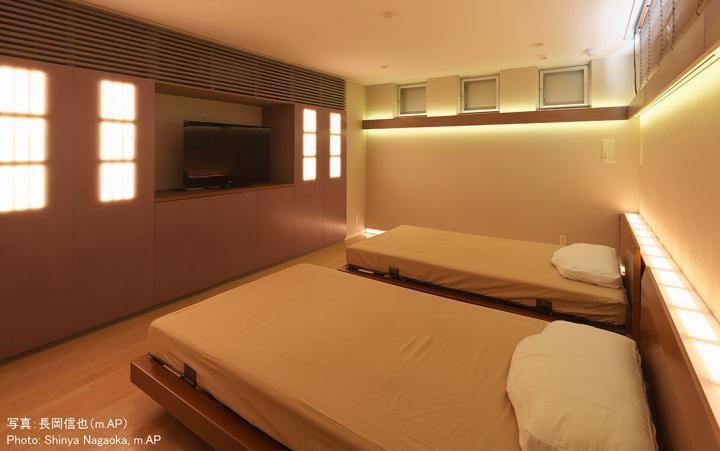At night, prolonged exposure to light could have negative impacts on human health. However, Japanese scientists have currently found a new kind of light with very few consequences for physiological variations during sleep.
 Researchers from the University of Tsukuba have found that exposure to specific types of light before sleep can have variable effects on energy metabolism during sleep. Specifically, participants who went to sleep after exposure to organic light-emitting diodes (OLEDs), which emit polychromatic white light that contains less blue light than light-emitting diodes (LEDs), exhibited significantly decreased energy expenditure, core body temperature, and increased fat oxidation, indicating fewer negative health consequences compared with after nighttime exposure to LEDs. Thus, OLEDs may be a worthwhile alternative to LED lighting, especially for exposure at night. Image Credit: University of Tsukuba.
Researchers from the University of Tsukuba have found that exposure to specific types of light before sleep can have variable effects on energy metabolism during sleep. Specifically, participants who went to sleep after exposure to organic light-emitting diodes (OLEDs), which emit polychromatic white light that contains less blue light than light-emitting diodes (LEDs), exhibited significantly decreased energy expenditure, core body temperature, and increased fat oxidation, indicating fewer negative health consequences compared with after nighttime exposure to LEDs. Thus, OLEDs may be a worthwhile alternative to LED lighting, especially for exposure at night. Image Credit: University of Tsukuba.
Scientists from the University of Tsukuba made a comparison of the impacts of light-emitting diodes (LEDs), which have been adopted extensively for their energy-saving properties, with organic light-emitting diodes (OLEDs) on physical processes that take place during sleep. The study was published in the journal Scientific Reports in June 2021.
Polychromatic white LEDs discharge a large amount of blue light, which has been connected with several negative health effects, such as metabolic health. On the other hand, OLEDs discharge polychromatic white light with less blue light.
But the effect of night exposure to LED and OLED has not been compared relating to variations in energy metabolism during sleep. This was the aim of the researchers of the University of Tsukuba.
Energy metabolism is an important physiological process that is altered by light exposure. We hypothesized that compared with LEDs, OLED exposure would have a reduced effect on sleep architecture and energy metabolism, similar to that of dim light.
Kumpei Tokuyama, Study Senior Author and Professor, University of Tsukuba
For this hypothesis to be validated, 10 male participants were exposed to LED, OLED, or dim light for 4 hours before they slept in a metabolic chamber. Then, the team quantified fat oxidation, core body temperature, energy expenditure, and 6-sulfatoxymelatonin, which is a measure of melatonin levels, during sleep. In recent times, the participants had not participated in shift work or traveled.
The results confirmed part of our hypothesis. Although no effect on sleep architecture was observed, energy expenditure and core body temperature during sleep were significantly decreased after OLED exposure. Furthermore, fat oxidation during sleep was significantly lower after exposure to LED compared with OLED.
Kumpei Tokuyama, Study Senior Author and Professor, University of Tsukuba
Fat oxidation during sleep was correlated in a positive way with 6-sulfatoxymelatonin levels after exposure to OLED, thereby indicating that the effect of melatonin activity on energy metabolism changes based on the kind of light exposure.
Thus, light exposure at night is related to fat oxidation and body temperature during sleep. Our findings suggest that specific types of light exposure may influence weight gain, along with other physiological changes.
Kumpei Tokuyama, Study Senior Author and Professor, University of Tsukuba
In several activities and occupations, people are exposed to artificial light before sleep. New data regarding the impacts of various types of light on physical processes might streamline the choice of alternative light sources to reduce the negative impacts of nighttime light exposure.
Moreover, such findings improve the knowledge of the role of light in energy metabolism during sleep.
This study was financially supported by the Japan Society for the Promotion of Science (KAKENHI grant no. JP 20H04120), and the Japan Science and Technology Agency’s Center for Innovation (grant no. JPMJCE1312). No competing interests were announced by the authors.
Journal Reference:
Ishihara, A., et al. (2021) Metabolic responses to polychromatic LED and OLED light at night. Scientific Reports. doi.org/10.1038/s41598-021-91828-6.
Source: https://www.tsukuba.ac.jp/en/